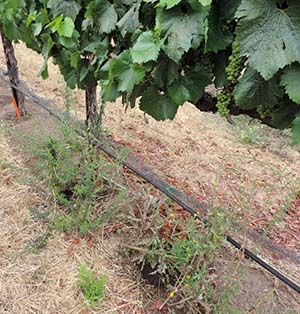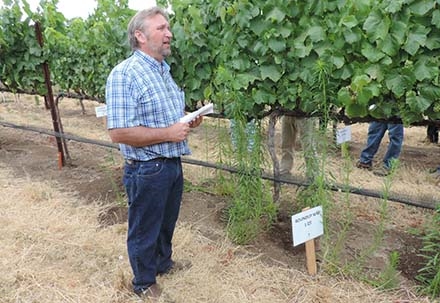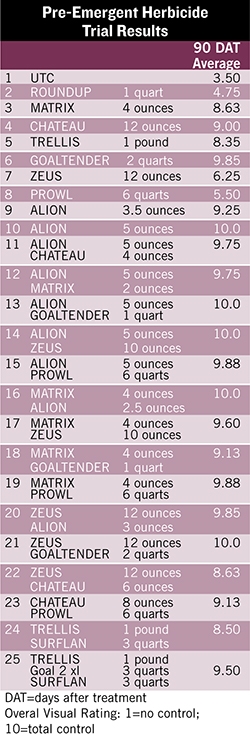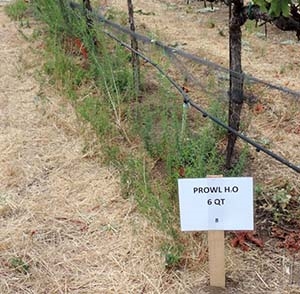Here's an article by Paul Franson | Wines & Vines | 07.22.2014
Napa, Calif.—Last week John Roncoroni, a Napa County UC Cooperative Extension weed science advisor, held a field demonstration about the efficacy of herbicides newly registered for vineyard application. He had laid out 25 treatment plots and rated the herbicides for weed control in vineyards.
The trials demonstrated that some new herbicides are very effective, especially if a mix of more than one is applied. But they also showed how ineffective some herbicides were against troublesome, newly arrived weeds.
The trial regimen
The test was held in south Napa Valley near Carneros. It was for pre-emergent herbicides, though each application included Roundup systemic herbicide in case any weeds had geminated unseen, plus AMSPro surfactant to improve penetration.
The plots had been cleared during the winter with glyphosate (such as Roundup) and Shark (carfentrazone, a contact herbicide that is mixed with glyphosate to help control some of the tolerant weeds). The applications were made in February just before significant rains (8.85 inches within a week).
The plots were 25 feet long by 6 feet wide under the vines, and they were swept clear of leaves before application.
The treatments were made at 30 gallons of water per acre at various rates and combinations of herbicides. They were applied with a CO2 backpack sprayer with two 8002 nozzles, each delivering 700 ml per minute. Roncoroni said that 30 to 50 gallons of water per acre seemed about optimum for adequate coverage.
No weeds were visible at the time of treatment.
All of the herbicides are registered. Roncoroni works exclusively with registered materials in Napa, saying: “The grapes are too expensive to destroy! Those trials are made with lower priced grapes in the Central Valley.”
Glyphosate is widely used in vineyards but some weeds have developed resistance to it, and others (some new to the region) are tolerant of it.
He applies the treatments in January or February, as they require rains to be activated, but they're only effective for 4 to 6 months. Vineyards may require mid-season spraying.
Rely is a preferred contact herbicide for mid-season and post-harvest spraying after pre-emergent herbicides have become ineffective and can't be applied again, but it is in short supply because of demand in the Southeast for use with cotton and soybeans fighting glyphosate-resistant weeds. Rely won't kill the vines if it gets on suckers, just the suckers, while glyphosate can get into the vine and cause problems in the spring.
“In the old days, they used paraquat,” said Roncoroni. Paraquat is still registered for use in grapes but requires special permitting and safety equipment for use.
Some of the new herbicides have some post-emergent properties, but one of the longest lasting, Alion (indaziflam), has none. In any case, Roncoroni emphasizes that mixes of two or more herbicides are generally more effective than a single product.
The results
Many of the herbicides did a pretty good job by themselves, notably Matrix (rimsulfuron), Chateau (flumioxazin), Goaltender (oxyfluorfen), and especially Alion at 5 ounces of product per acre.
However, the mix of Alion plus another herbicide such as Prowl (pendimethalin) and Zeus (sulfentrazone) was the most effective. Zeus plus Goaltender did particularly well, too.
However, the quantities obviously matter. Alion, for example, was significantly more effective at 5 ounces than at 3 ounces per acre. Some materials required much larger quantities per acre than others.
A note on some specific weeds
Roncoroni considers horseweed (Conyza canadensis) (often called mare's tail) and panicle willowherb (Ebilobium bracycarpum), both relatively new to the area and his biggest challenges at present

Horseweed (the preferred name) has gone from tolerance to resistance to glyphosate in the San Joaquin Valley. “It germinates almost year-round, so can crop up if you water after harvest,” said Roncoroni.
He said that it was relatively new in Napa Valley, and it's a real problem. “It can be 0.5 inches in diameter and 6 to 8 feet tall. It uses a lot of water and can interfere with harvesting.”
Fortunately, Matrix, Chateau and Alion are very effective in killing it, and the first two have some post-emergent effectiveness. “If it germinates in the fall, you need post-emergent herbicide to kill it.”
Glyphosate will only kill small plants (4-5 in. tall).
Rely can control both horseweed and willowherb, but again when they are relatively small.
Roncoroni added. “The only thing that will kill large willowherb or horseweed is iron—hardened on the end of a handle.'
Roncoroni noted that the pre-emergent herbicides aren't effective against field bindweed (Convolvulus arvensis), which has very deep rhizomes. It is best controlled with spot application when the morning-glory relative is blooming. This may take several years once established.
Turkey mullein (Croton setigerus) is a common weed, but Roncoroni says it isn't a big water user and doesn't grow very big so isn't a real problem. It prefers uncultivated soil, which is common in vineyards.
Roncoroni's trials showed that some of the new herbicides are very effective against weeds including tenacious types, but he noted that he didn't have information on price. Some like Alion are so new that other weeds may prove resistant to them in the future, but most resistance has been found recently in the overuse of post-emergent herbicides by themselves.
Organic herbicides
Roncoroni didn't include any organic herbicides in the trials since no new ones have been approved recently, though he expects some soon and will conduct trials with them. He fears, however, that they may be expensive and not effective against tough weeds.
Original source (Reprinted with permission from Wines & Vines)


